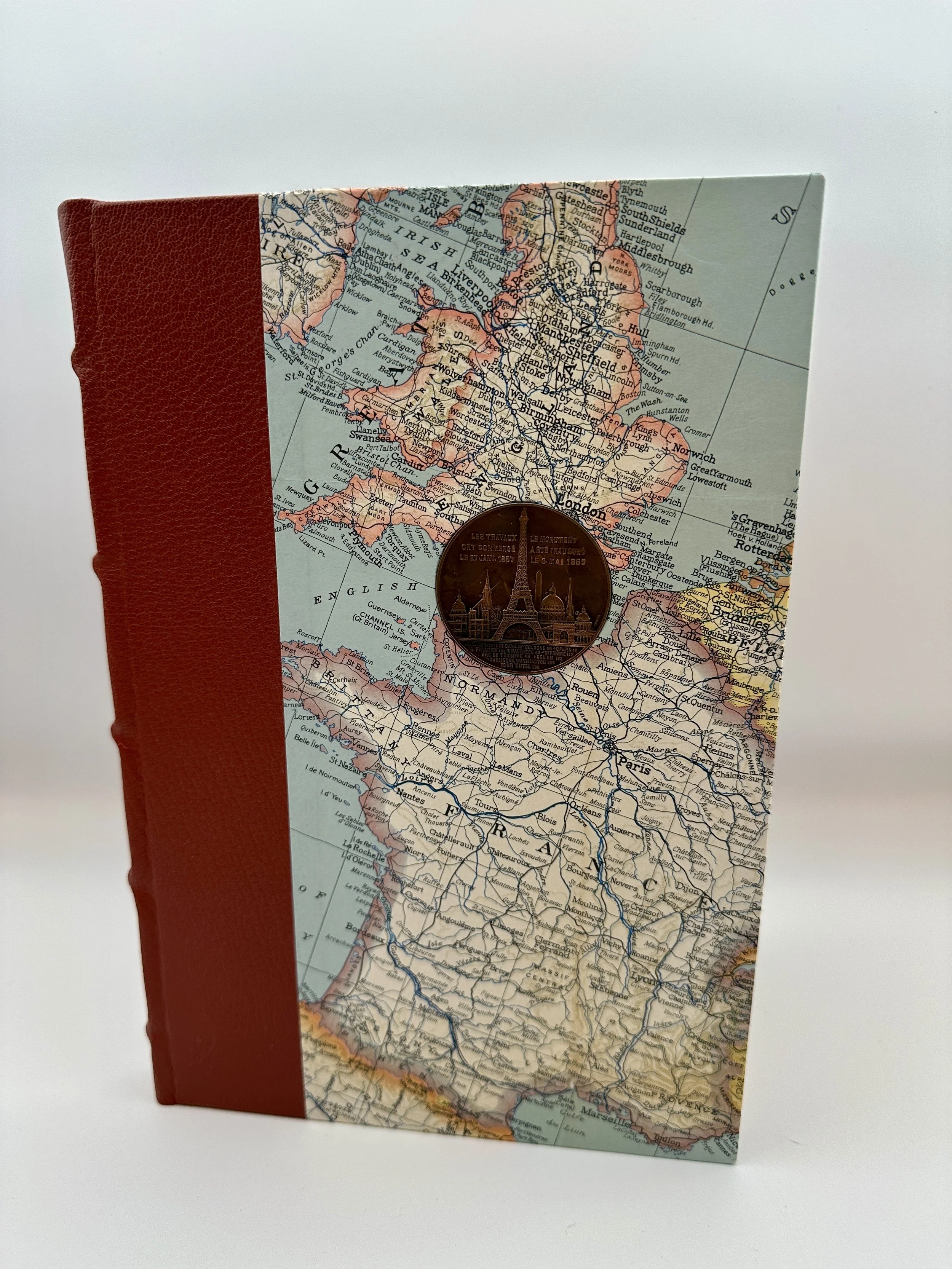 Image 1 of 10
Image 1 of 10

 Image 2 of 10
Image 2 of 10

 Image 3 of 10
Image 3 of 10

 Image 4 of 10
Image 4 of 10

 Image 5 of 10
Image 5 of 10

 Image 6 of 10
Image 6 of 10

 Image 7 of 10
Image 7 of 10

 Image 8 of 10
Image 8 of 10

 Image 9 of 10
Image 9 of 10

 Image 10 of 10
Image 10 of 10

Ascension
This archival, hand-sewn journal/sketchbook is made from 100 gsm, rose Hahnemühle Ingres mouldmade paper from Germany, sewn with Irish linen thread in the linked stitch pattern that dates back at least to the Ancient Copts. It allows the book to lay open easily to any page.
This book’s endbands are blue and white cotton, and its bookmark is blue satin ribbon. Its spine is covered goatskin from Rocky Mountain Leather Supply in Utah, and its boards are wrapped in a 1940 map of Europe.
Treasure binding began with monks in the 6th Century who would encrust volumes with jewels. During the Renaissance, there was a resurgence in treasure binding. This is a contemporary revival of the treasure binding in which a lucky charm has been embedded in the cover of this book.
The talisman in this book is a medal for climbing the Eiffel Tower in the year it opened: 1889. On its face, it says that work on the monument began on 27 January 1887 and ended on 6 May 1889. It’s obverse is dated 1889 and states that it is the “souvenier do mon ascension au 1er etage de la tour eiffel.” Climb higher.
This book is approximately 6.5 x 9” with a few more than 150 blank pages.
This archival, hand-sewn journal/sketchbook is made from 100 gsm, rose Hahnemühle Ingres mouldmade paper from Germany, sewn with Irish linen thread in the linked stitch pattern that dates back at least to the Ancient Copts. It allows the book to lay open easily to any page.
This book’s endbands are blue and white cotton, and its bookmark is blue satin ribbon. Its spine is covered goatskin from Rocky Mountain Leather Supply in Utah, and its boards are wrapped in a 1940 map of Europe.
Treasure binding began with monks in the 6th Century who would encrust volumes with jewels. During the Renaissance, there was a resurgence in treasure binding. This is a contemporary revival of the treasure binding in which a lucky charm has been embedded in the cover of this book.
The talisman in this book is a medal for climbing the Eiffel Tower in the year it opened: 1889. On its face, it says that work on the monument began on 27 January 1887 and ended on 6 May 1889. It’s obverse is dated 1889 and states that it is the “souvenier do mon ascension au 1er etage de la tour eiffel.” Climb higher.
This book is approximately 6.5 x 9” with a few more than 150 blank pages.
This archival, hand-sewn journal/sketchbook is made from 100 gsm, rose Hahnemühle Ingres mouldmade paper from Germany, sewn with Irish linen thread in the linked stitch pattern that dates back at least to the Ancient Copts. It allows the book to lay open easily to any page.
This book’s endbands are blue and white cotton, and its bookmark is blue satin ribbon. Its spine is covered goatskin from Rocky Mountain Leather Supply in Utah, and its boards are wrapped in a 1940 map of Europe.
Treasure binding began with monks in the 6th Century who would encrust volumes with jewels. During the Renaissance, there was a resurgence in treasure binding. This is a contemporary revival of the treasure binding in which a lucky charm has been embedded in the cover of this book.
The talisman in this book is a medal for climbing the Eiffel Tower in the year it opened: 1889. On its face, it says that work on the monument began on 27 January 1887 and ended on 6 May 1889. It’s obverse is dated 1889 and states that it is the “souvenier do mon ascension au 1er etage de la tour eiffel.” Climb higher.
This book is approximately 6.5 x 9” with a few more than 150 blank pages.
